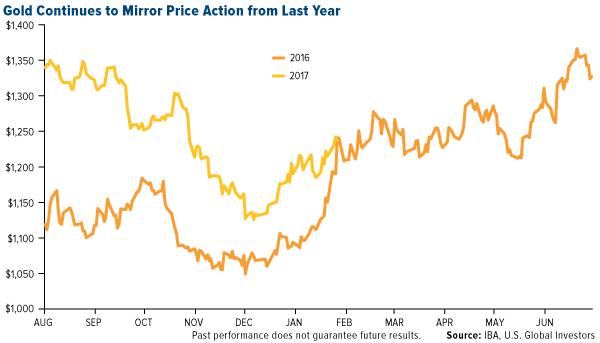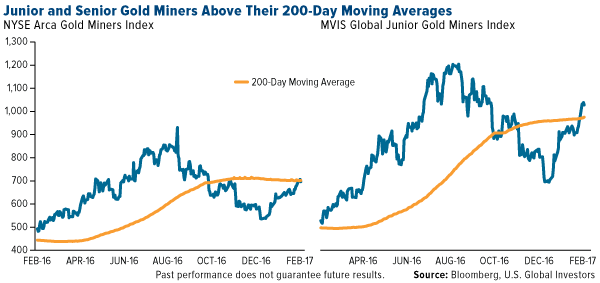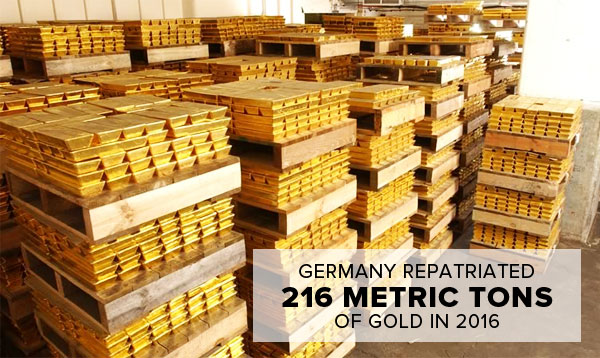Economic Outlook
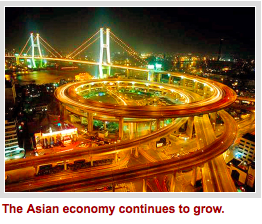 If you only read the headlines, it’s easy to believe a trade war could be looming with China and Asia.
If you only read the headlines, it’s easy to believe a trade war could be looming with China and Asia.
In fact, if you believe the rhetoric, you’d take a second look before investing a dime of your hard-earned money in anything related to the region.
But it’s just rhetoric – and misleading rhetoric to boot. Here’s what is really happening …
The Trans-Pacific Partnership (TPP) was set to be the largest regional trade accord in history.
The TPP would have set new terms for trade and business investment among the United States and 11 other Pacific Rim nations: A wide-ranging group with an annual gross domestic product of nearly $28 trillion, representing roughly 40 percent of global GDP and one-third of world trade.
President Trump didn’t like the deal and thinks a more U.S. friendly deal can be made. So his administration is pushing for bilateral trade agreements between these each of these nations in the future.
In other words, getting rid of TPP wasn’t the end of trade negotiations, it was the beginning. There’s going to be a ton of deals coming down the pike.
And a lot of trade talk in China and Asia is going to go that way: Rhetoric and Trump posturing to begin with, deal making in the end.
Then, there’s tax reform and the possibility of President Trump’s administration implementing a border-adjustment tax.
If passed, it could cause companies to pay 20% more for imports than for domestic goods. Meanwhile exporters would pay no income tax on revenue from goods they sell to foreign customers.
At face value, a tax move like this could have China and Asian companies shaking in their boots. But there is still a lot to negotiate surrounding a border-adjustment tax, and too much is still up in the air. There will be winners and some losers, but it’s just too early to tell.
And finally, the political tension in the region – specifically surrounding the South China Sea – could be a hot bed of conflict in the years to come.
China continues to occupy the South China Sea region, and it’s acting very aggressive toward the region’s huge oil and gas reserves, not to mention its strategic shipping lanes.
This is definitely something to keep an eye on – as my war cycles are ramping higher – war in the region is always a possibility.
I’m not downplaying these factors – including trade, tax, and potential conflicts – but I’m not one bit worried about the long-term prospects for China and the rest of Asia.
The fact is the economies of China and the rest of Asia, particularly Southeast Asia are doing just fine. The major underlying factors – including an expanding population, rising incomes and dynamic monetary policy – are more bullish than ever.
And that’s going to keep the Chinese and Asian growth story alive. Consider …
To cope with the challenges of a growing population, infrastructure spending in the region is ramping up once again. About $5.3 trillion is expected to be invested into Asian infrastructure between 2015 and 2025.
In countries like Thailand, the Philippines, Indonesia, and Malaysia, plans for massive infrastructure projects are going to ramp up modernization efforts, improving everything from roads to telecommunication networks. In fact, in the Philippines, $160 billion is projected to be spent on building infrastructure over the next six years.
President Trump won’t implement trade policies that adversely impact the U.S economy. And a massive trade war would do just that – big time.
Asia is still the rising star in the global economy and it’s going to stay that way for years to come.
That’s exactly why I am looking to gain more exposure in the region. But I still don’t recommend going all in – not just yet.
It’s tricky: You have to know when to get in and when to get out. And that’s just the kind of advice I give the members of my services, Real Wealth Report and Supercyle Trader.
Best,
Larry

The stock market continues to make new highs, yet none of the signs which accompany a market bubble are evident. Investors are asking, “When will the Dow finally correct?” By “correct” they mean “decline.” However, a market correction doesn’t always entail a decline for the major averages and can sometimes take the form of a lateral consolidation or trading range. That appears to be the case for the 2-month period from December through early February when the Dow and S&P made little headway.
In fact, in January the Dow Jones Industrial Average (DJI) recorded its tightest trading range of only 1.1% in over 100 years. This continues a prolonged sideways pattern in the Dow and other averages since mid-December when the post-election rally reached a plateau. The question everyone was asking was whether this plateau was merely a temporary “pause that refreshes” in an ongoing rally or the end of the rally and the prelude to another market setback. The Dow provided the answer to that with the last week’s breakout above the top of the trading range ceiling. It has rallied each day since, putatively on the hopes generated by President Trump’s forthcoming tax-related announcement.
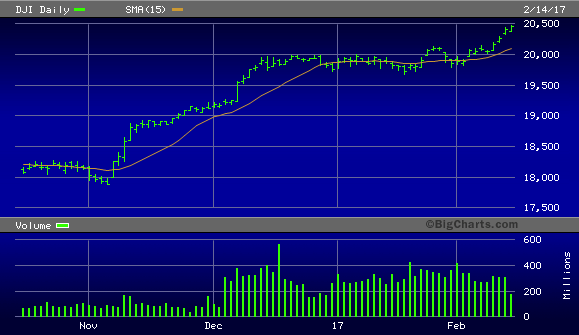
While the bull market in equities continues, a surprising number of investors are either mistrustful of the rally or outright bearish. According to a recent article in BBC News, there are a growing number of wealthy and politically liberal U.S. citizens who are doing things in the wake of Donald Trump’s election that were commonly seen by politically conservative citizens during the Obama years. That is, they are buying guns, becoming survivalists, and preparing for an impending catastrophe related to the Trump presidency, the article reported.
It was also reported that a number of wealthy Americans are preparing for what they believe is the apocalypse. According to Business Insider, some have purchased underground bunkers while other wealthy individuals are planning to emigrate to New Zealand. “Saying you’re ‘buying a house in New Zealand’ is kind of a wink, wink, say no more,” said Steve Huffman, CEO of the Reddit web site. “Once you’ve done the Masonic handshake, they’ll be, like, ‘Oh, you know, I have a broker who sells old ICBM silos, and they’re nuclear hardened, and they kind of look like they would be interesting to live in.”
The common denominator in these accounts is fear among the upper class. The dread of an uncertain future which was pervasive among America’s middle class for much of the last eight years has now been transferred to the upper class. While it might be premature to ascribe this to the recent rush back into gold, bond funds and other safe-haven investments, it would seem that there is just enough uncertainty among the upper crust to account for the lack of movement in the major stock market indices since December.
Tight, narrow trading ranges in the major indices are launching pads for major moves in either direction. In the context of a bull market, they typically represent rest and consolidation before the next move higher. The odds technically favored this outcome, yet a substantial number of investors still don’t believe in the strength of the bull market. This is reflected in the manifestations of fear among the upper class mentioned above, as well as in the path the market rally is taking.
There is talk among some observers that the market is undergoing a “melt-up”. This is an erroneous application of that term. A classic melt-up is characterized by a runaway, almost straight-up and sustained market rally on high volume with widespread participation. The trajectory of the major indices since November can hardly be described as “melting up.” Rather, the market’s path has been measured and well-ordered, as the daily chart of the NYSE Composite Index (NYA) attests.

The real melt-up phase of this bull market hasn’t even started yet. We’ll know it has arrived when we see runaway stock prices coupled with increased participation among the legion of retail investors still on the sidelines. Even institutional investors are surprisingly tempered in their usual optimism, as expressed in their collective 2017 forecasts. Melt-ups have a way of surprisingly even the bulls in how high they carry the market averages before peaking. For now, though, a combination of fear and cautious optimism holds sway among investors and this alone is enough to argue that the bull market still has legs.
Mastering Moving Averages
The moving average is one of the most versatile of all trading tools and should be a part of every investor’s arsenal. Far more than a simple trend line, it’s a dynamic momentum indicator as well as a means of identifying support and resistance across variable time frames. It can also be used in place of an overbought/oversold oscillator when used in relationship to the price of the stock or ETF you’re trading in.
In my latest book, Mastering Moving Averages, I remove the mystique behind stock and ETF trading and reveal a completely simple and reliable system that allows retail traders to profit from both up and down moves in the market. The trading techniques discussed in the book have been carefully calibrated to match today’s fast-moving and sometimes volatile market environment. If you’re interested in moving average trading techniques, you’ll want to read this book.
Order today and receive an autographed copy along with a copy of the book, The Best Strategies For Momentum Traders. Your order also includes a FREE 1-month trial subscription to the Momentum Strategies Report newsletter:
http://www.clifdroke.com/books/masteringma.html
Clif Droke is a recognized authority on moving averages and internal momentum. He is the editor of the Momentum Strategies Report newsletter, published since 1997. He has also authored numerous books covering the fields of economics and financial market analysis. His latest book is Mastering Moving Averages. For more information visit www.clifdroke.com


Emerging Markets will out perform the US stocks over the next 10 years. Other topics include Donald Trump, India, China economy, Commodity rally and MORE….in this 13 minute interview
…also from Marc: Trump is a very Great Talker


 As the world continues to experience the “reflation trade,” we are witnessing historic breakouts. What this means for the gold and silver markets is fascinating.
As the world continues to experience the “reflation trade,” we are witnessing historic breakouts. What this means for the gold and silver markets is fascinating.
From top Citi analyst Tom Fitzpatrick: “The London Metals Exchange saw a bullish breakout at the end of last week as we made higher highs and rallied through the trend line resistance (see chart below).”


